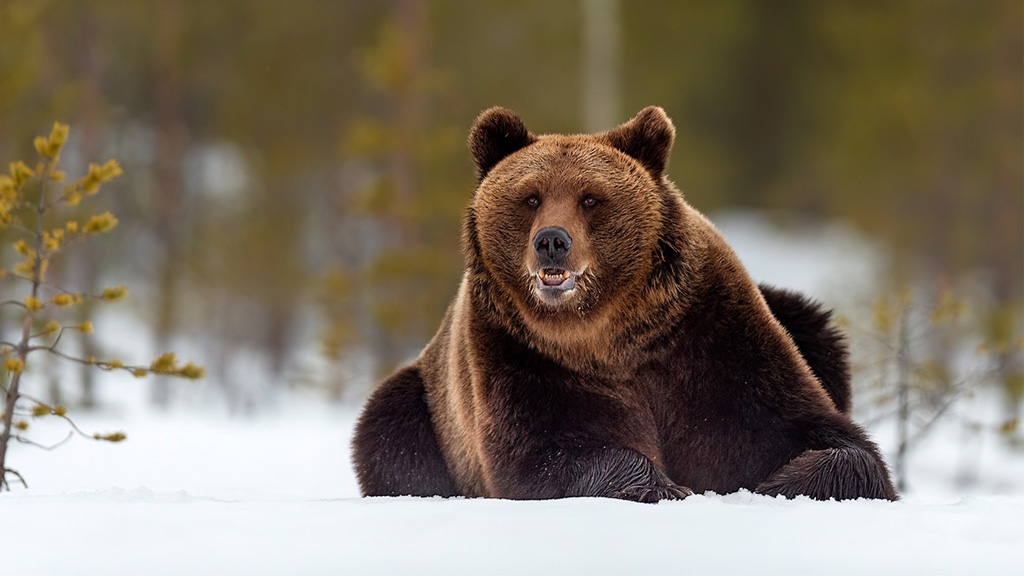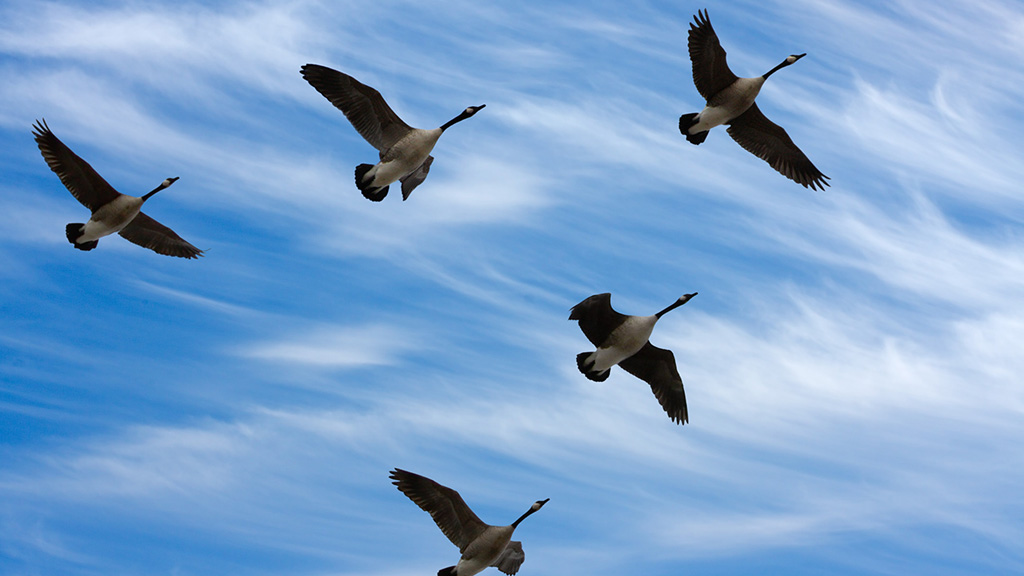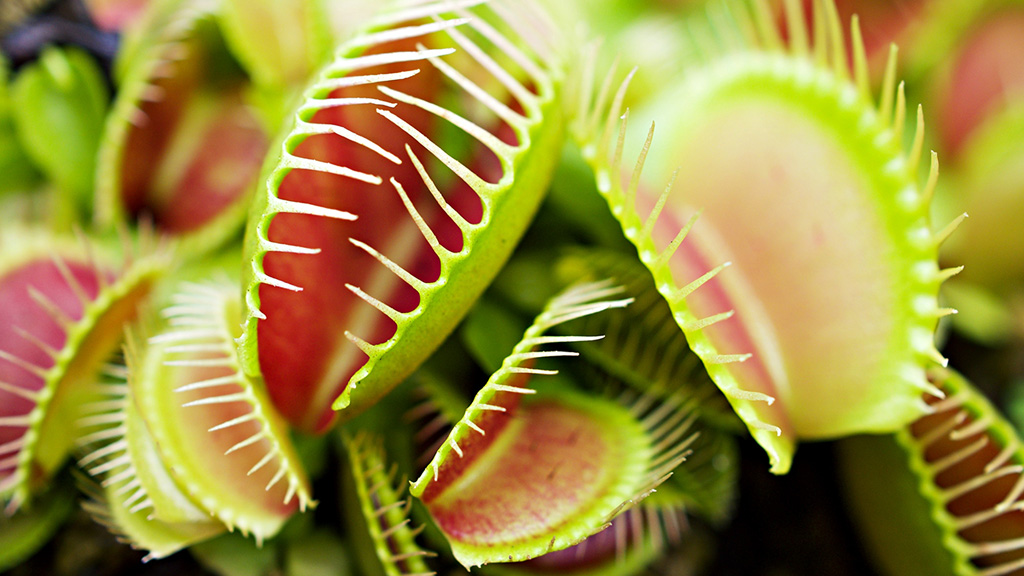Behavioral Adaptations
Adaptaciones Conductuales

Brown bear resting on snow after hibernation
Oso pardo descansando sobre la nieve después de la hibernación
English | LEVEL A

Brown bear resting on snow after hibernation
Oso pardo descansando sobre la nieve después de la hibernación
Plants and animals are amazing! They have special ways of acting, called behavioral adaptations, that help them live in their homes. A behavioral adaptation is something an animal or plant does to stay alive, find food, stay safe, or raise its young.
Let’s start with animals. Have you seen birds flying south when it gets colder? This is called migration. Birds fly to warmer places to find food and stay warm during winter. Migration is a behavioral adaptation that helps them survive.
Bears have another trick. They hibernate! Hibernation means bears sleep for a long time in winter. Before they hibernate, they eat a lot of food to store energy. While they sleep, their bodies use this energy to stay alive. Hibernation helps them survive when it’s too cold, and food is scarce, or hard to find.

A flock of geese fly in v-formation as they migrate
Una bandada de gansos vuelan en formación de V mientras migran
Other animals, like deer, stay safe by being very alert. They listen carefully and watch for danger, like wolves or other predators. This behavior keeps them safe from harm.
Plants have behavioral adaptations, too, even though they don’t move like animals. For example, sunflowers turn their faces toward the sun during the day. This helps them soak up sunlight, which they need to grow.
The Venus flytrap is a clever plant that catches insects. Its special leaves snap shut when an insect touches them. This helps the plant get food. In deserts, some plants save water by opening tiny holes in their leaves at night. It’s cooler then, so they lose less water. This is a smart way to live in dry, hot places.

A Venus flytrap waiting for insects
Una Venus atrapamoscas esperando insectos
Even seeds have behaviors! Some seeds wait to start growing until the weather is perfect. This way, the plant has a better chance of growing big and strong.
These behaviors in plants and animals are very important. They help living things survive in all kinds of environments, like cold forests, hot deserts, or busy meadows.
Behavioral adaptations show us how smart and amazing nature can be. By watching plants and animals, we can learn so much about the incredible ways they live and grow!
¡Las plantas y los animales son increíbles! Tienen formas especiales de actuar, llamadas adaptaciones conductuales, que les ayudan a vivir en sus hogares. Una adaptación conductual es algo que un animal o una planta hace para sobrevivir, encontrar alimento, mantenerse a salvo o criar a sus crías.
Empecemos con los animales. ¿Has visto aves volando hacia el sur cuando hace más frío? Esto se llama migración. Las aves vuelan a lugares más cálidos para encontrar alimento y mantenerse calientes durante el invierno. La migración es una adaptación conductual que les ayuda a sobrevivir.
Los osos tienen otro truco: ¡hibernan! La hibernación significa que los osos duermen mucho tiempo en invierno. Antes de hibernar, comen mucho alimento para almacenar energía. Mientras duermen, sus cuerpos utilizan esta energía para mantenerse vivos. La hibernación les ayuda a sobrevivir cuando hace demasiado frío y el alimento escasea o es difícil de encontrar.

A flock of geese fly in v-formation as they migrate
Una bandada de gansos vuelan en formación de V mientras migran
Otros animales, como los ciervos, se mantienen a salvo estando muy alertas. Escuchan atentamente y observan el peligro, como los lobos u otros depredadores. Este comportamiento las protege de cualquier daño.
Las plantas también tienen adaptaciones conductuales, aunque no se mueven como los animales. Por ejemplo, los girasoles giran sus caras hacia el sol durante el día. Esto les ayuda a absorber la luz solar, que necesitan para crecer.
La Venus atrapamoscas es una planta inteligente que atrapa insectos. Sus hojas especiales se cierran de golpe cuando un insecto las toca. Esto le ayuda a obtener alimento. En los desiertos, algunas plantas ahorran agua abriendo pequeños agujeros en sus hojas por la noche. Hace más frío, así que pierden menos agua. Esta es una forma inteligente de vivir en lugares secos y cálidos.

A Venus flytrap waiting for insects
Una Venus atrapamoscas esperando insectos
¡Incluso las semillas tienen comportamientos! Algunas semillas esperan a que el clima sea perfecto para empezar a crecer. De esta manera, la planta tiene más posibilidades de crecer grande y fuerte.
Estos comportamientos en plantas y animales son muy importantes. Ayudan a los seres vivos a sobrevivir en todo tipo de entornos, como bosques fríos, desiertos calurosos o praderas con mucha vegetación.
Las adaptaciones conductuales nos muestran lo inteligente y asombrosa que puede ser la naturaleza. ¡Observando las plantas y los animales, podemos aprender mucho sobre las increíbles formas en que viven y crecen!
Plants and animals are amazing! They have special ways of behaving, called behavioral adaptations, that help them survive in their habitats. A behavioral adaptation is something an animal or plant does to live, find food, stay safe, or raise its young.
Let’s start with animals. Have you ever seen birds flying south in the fall? This is called migration. Birds fly to warmer places where they can find food and stay warm during the winter. Migration is a behavioral adaptation that helps them survive the cold months.
Another example is how bears hibernate. Hibernation means that bears sleep for a long time during the winter. Before hibernating, bears eat a lot of food to store energy. While they sleep, their bodies use this stored energy to stay alive. Hibernation helps certain animals survive when it’s too cold, and food is hard to find.

A flock of geese fly in v-formation as they migrate
Una bandada de gansos vuelan en formación de V mientras migran
Some animals, like deer, are very good at staying alert to danger. They listen for sounds and watch for predators, like wolves or bears, that might want to eat them. This behavior keeps them safe.
Plants also have behavioral adaptations, even though they don’t move like animals. For example, some flowers, like sunflowers, turn toward the sun during the day. This helps them get as much sunlight as possible, which they need to grow and make food.
Other plants, like the Venus flytrap, have a clever way to catch insects. The Venus flytrap has special leaves that snap shut when an insect touches them. This behavior helps the plant get nutrients from the insect.

A Venus flytrap waiting for insects
Una Venus atrapamoscas esperando insectos
In dry places like deserts, some plants open tiny holes in their leaves at night. This saves water because it’s cooler at night, and less water evaporates. This is a great adaptation for living in hot, dry places.
Even seeds show behavior! Some seeds stay asleep, or dormant, until the weather is just right for growing. This way, the plant has a better chance of growing big and strong when conditions are good.
All of these behaviors in plants and animals are important. They help living things survive in different environments, whether it’s a cold forest, a sunny desert, or a busy meadow.
Behavioral adaptations show us how smart and resourceful nature can be. By watching plants and animals closely, we can learn more about the amazing ways they live and thrive.
¡Las plantas y los animales son increíbles! Tienen formas especiales de comportarse, llamadas adaptaciones conductuales, que les ayudan a sobrevivir en sus hábitats. Una adaptación conductual es algo que un animal o una planta hace para vivir, encontrar alimento, mantenerse a salvo o criar a sus crías.
Comencemos con los animales. ¿Alguna vez has visto aves volando hacia el sur en otoño? Esto se llama migración. Las aves vuelan a lugares más cálidos donde pueden encontrar alimento y mantenerse calientes durante el invierno. La migración es una adaptación conductual que les ayuda a sobrevivir los meses fríos.
Otro ejemplo es la hibernación de los osos. La hibernación significa que los osos duermen mucho tiempo durante el invierno. Antes de hibernar, los osos comen mucho alimento para almacenar energía. Mientras duermen, sus cuerpos utilizan esta energía almacenada para mantenerse vivos. La hibernación ayuda a ciertos animales a sobrevivir cuando hace demasiado frío y es difícil encontrar alimento.

A flock of geese fly in v-formation as they migrate
Una bandada de gansos vuelan en formación de V mientras migran
Algunos animales, como los ciervos, son muy buenos para mantenerse alerta ante el peligro. Escuchan sonidos y vigilan a depredadores, como lobos u osos, que podrían querer comérselos. Este comportamiento los mantiene a salvo.
Las plantas también tienen adaptaciones conductuales, aunque no se mueven como los animales. Por ejemplo, algunas flores, como los girasoles, se orientan hacia el sol durante el día. Esto les ayuda a obtener la mayor cantidad de luz solar posible, la cual necesitan para crecer y producir alimento.
Otras plantas, como la Venus atrapamoscas, tienen una forma inteligente de atrapar insectos. La Venus atrapamoscas tiene hojas especiales que se cierran de golpe cuando un insecto las toca. Este comportamiento ayuda a la planta a obtener nutrientes del insecto.

A Venus flytrap waiting for insects
Una Venus atrapamoscas esperando insectos
En lugares secos como los desiertos, algunas plantas abren pequeños agujeros en sus hojas por la noche. Esto ahorra agua porque hace más fresco por la noche y se evapora menos agua. Esta es una gran adaptación para vivir en lugares cálidos y secos.
¡Incluso las semillas muestran comportamiento! Algunas semillas permanecen dormidas, o en estado latente, hasta que el clima es ideal para crecer. De esta manera, la planta tiene más posibilidades de crecer grande y fuerte cuando las condiciones son favorables.
Todos estos comportamientos en plantas y animales son importantes. Ayudan a los seres vivos a sobrevivir en diferentes entornos, ya sea un bosque frío, un desierto soleado o una pradera concurrida.
Las adaptaciones conductuales nos muestran lo inteligente y llena de recursos que puede ser la naturaleza. Al observar de cerca a las plantas y los animales, podemos aprender más sobre las asombrosas formas en que viven y prosperan.